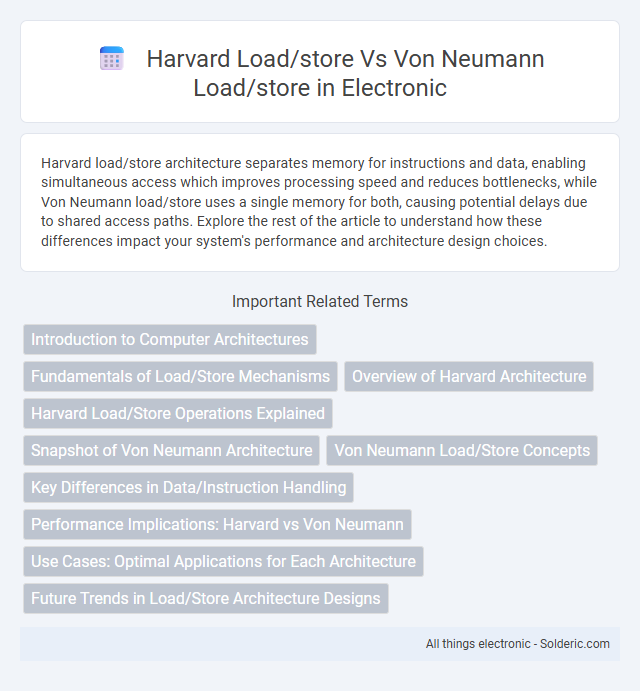Harvard load/store architecture separates memory for instructions and data, enabling simultaneous access which improves processing speed and reduces bottlenecks, while Von Neumann load/store uses a single memory for both, causing potential delays due to shared access paths. Explore the rest of the article to understand how these differences impact your system's performance and architecture design choices.
Comparison Table
| Feature | Harvard Architecture Load/Store | Von Neumann Architecture Load/Store |
|---|---|---|
| Memory Organization | Separate instruction and data memory | Unified memory for instructions and data |
| Load/Store Operation | Simultaneous instruction fetch and data access possible | Instruction fetch and data access share the same bus, cannot occur simultaneously |
| Performance | Faster load/store throughput due to parallelism | Potential bottleneck at memory bus slowing load/store operations |
| Complexity | More complex hardware with dual memory interfaces | Simpler design with single memory interface |
| Typical Use | Embedded systems, DSPs requiring high-speed data processing | General-purpose computing with simpler control flow |
Introduction to Computer Architectures
Harvard load/store architecture separates memory for instructions and data, enabling simultaneous access and increased throughput, while Von Neumann load/store architecture uses a single memory space for both, causing potential bottlenecks due to sequential access. This fundamental difference impacts the efficiency of instruction execution and memory handling in computer architectures. Understanding these distinctions helps you optimize system performance based on workload characteristics.
Fundamentals of Load/Store Mechanisms
Harvard architecture separates instruction and data memory, enabling simultaneous load/store operations and reducing bottlenecks in data access. Von Neumann architecture uses a single memory space for both instructions and data, causing potential delays as load/store operations share the same bus. Your system's efficiency depends on how these fundamental load/store mechanisms handle memory access and throughput.
Overview of Harvard Architecture
Harvard Architecture separates memory into distinct storage for instructions and data, allowing simultaneous access and improving processing speed. This design contrasts with Von Neumann Architecture, which uses a single memory space for both instructions and data, potentially causing bottlenecks. Your system's performance benefits from Harvard's ability to fetch instructions and load/store data concurrently, optimizing execution efficiency.
Harvard Load/Store Operations Explained
Harvard load/store architecture separates instruction and data memory, allowing simultaneous access and increased throughput during load/store operations. In Harvard systems, your processor can fetch an instruction and perform a data load/store concurrently, enhancing pipeline efficiency and reducing stalls. This contrasts with Von Neumann architecture, where a unified memory for instructions and data requires load/store units to share access, often causing bottlenecks.
Snapshot of Von Neumann Architecture
Von Neumann architecture uses a single memory space for both instructions and data, causing load/store operations to compete for the same bus, which can create a bottleneck known as the Von Neumann bottleneck. In contrast, Harvard architecture separates memory for instructions and data, enabling simultaneous access and improving load/store efficiency. Understanding this difference helps optimize your system's performance by selecting the appropriate architecture for load/store operations.
Von Neumann Load/Store Concepts
Von Neumann load/store architecture utilizes a single shared memory space for both instructions and data, requiring sequential access which can lead to bottlenecks known as the Von Neumann bottleneck. Load/store instructions in this model involve fetching data from memory into registers and storing results back to memory using the same data path, impacting instruction throughput and latency. This architecture contrasts with Harvard architecture by mixing code and data in one memory, thereby influencing processor design and performance optimization strategies.
Key Differences in Data/Instruction Handling
Harvard load/store architectures separate data and instruction memory, enabling simultaneous access and increasing processing speed by reducing bottlenecks. Von Neumann load/store architectures use a single memory space for data and instructions, which can create a bottleneck because data and instructions cannot be fetched simultaneously. Your choice between these architectures impacts performance efficiency, with Harvard architecture generally offering faster data/instruction handling in embedded and real-time systems.
Performance Implications: Harvard vs Von Neumann
Harvard architecture separates instruction and data memory, enabling simultaneous access that significantly enhances throughput and reduces bottlenecks in load/store operations compared to Von Neumann architecture, which shares a single memory bus for both instructions and data. Consequently, Harvard architecture improves pipeline efficiency and minimizes latency, leading to higher overall system performance in compute-intensive applications. Von Neumann systems often encounter memory access collisions and increased cycle stalls, limiting their performance in tasks requiring frequent memory interactions.
Use Cases: Optimal Applications for Each Architecture
Harvard load/store architecture excels in real-time embedded systems and digital signal processing where separate instruction and data pathways enable higher throughput and reduced latency. Von Neumann load/store architecture is ideal for general-purpose computing and systems requiring flexible memory usage, as it uses a unified memory for instructions and data, simplifying design and programming. Your choice depends on whether your application benefits more from parallel throughput or simplicity and versatility in memory access.
Future Trends in Load/Store Architecture Designs
Future trends in load/store architecture designs are shifting towards hybrid models that combine the Harvard and Von Neumann principles to optimize memory access speed and efficiency. Advances in cache coherence and parallel processing are enhancing how load/store units manage data flow between instruction and data memory, reducing bottlenecks typical in traditional Von Neumann architectures. Your applications will benefit from these developments through faster execution times and improved energy efficiency in next-generation processors.
Harvard load/store vs Von Neumann load/store Infographic

 solderic.com
solderic.com